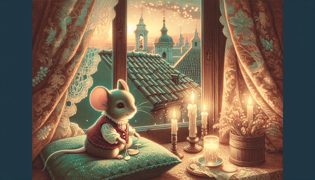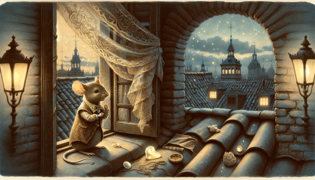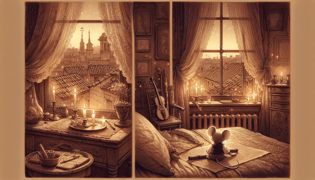Ratoncito Pérez: El Ratón de los Dientes Encantados
Reading Time: 10 min

About Story: Ratoncito Pérez: El Ratón de los Dientes Encantados is a Folktale from spain set in the 19th Century. This Poetic tale explores themes of Coming of Age and is suitable for Children. It offers Cultural insights. A whimsical mouse who trades a child's lost tooth for a secret treasure beneath the pillow.
Introduction
In a quiet alley near the Plaza Mayor, the soft rustle of parchment and a distant church bell marked the hour before bedtime. Little Lucía lay snug under her patchwork quilt, her favourite doll tucked under one arm. Outside, smoky shafts of moonlight painted silver filigree upon the wooden beams. A gentle breeze carried the faint scent of almond pastries from Don Rafael’s panadería, mingling with the honeyed aroma of beeswax candles. Lucía clutched a small bag containing her first lost tooth, heart fluttering like a sparrow.
High above, on tiled rooftops dusted by evening fog, Ratoncito Pérez peered through a tiny spyglass. His whiskers twitched as he polished a mother-of-pearl coin, more brilliant than starlight. He donned his crimson waistcoat, the fabric soft as a rose petal, and adjusted his golden pocket watch. Tonight, he thought, I visit Lucía. With a pirouette across terracotta shingles, he scurried down a wrought-iron gutter, his velvet slippers tapping a merry tune. The world below smelled of pine resin and distant tobacco smoke, a curious blend that made his whiskers quiver.
He slipped through the crack beneath Lucía’s door, its edges worn more smooth than river stones. In the lamplight, her room gleamed like a painted dream. Every toy seemed alive—Knitted bears with glassy eyes, silk ribbons dangling from a music box, and a portrait of a stern aunt wearing black lace. Ratoncito Pérez placed the tooth on a moss-green cushion beside Lucía’s pillow. Then he reached into his satchel, producing a copper coin that glowed like a campfire ember. “¡Venga ya!,” he whispered, as he left the coin where the tooth had rested.
By dawn, rosy light tiptoed across the horizon. Lucía awoke to the soft jingle of a coin and her tooth’s disappearance. Her eyes sparkled more bright than morning dew. She held the copper piece aloft, breathless. “¿Cómo puede ser esto real?,” she murmured. In that moment, every child’s dream fluttered into life, all thanks to a generous little mouse who thrived in moonlit adventures.
I. Origins Amid the Tiles
In the heart of old Madrid, where clay rooftops interlaced like a patchwork quilt, Ratoncito Pérez first discovered his calling. He was born in a crevice behind the grand Hotel de Oriente, where the scent of roasted chestnuts drifted each winter evening. His parents told stories of brave mice who danced in palace kitchens, but Pérez felt drawn to quieter wonders. One night, he found a lost tooth shimmering under a crystal ewer in a noble child’s chamber. He’d never seen anything so pure. The tooth glowed pale as moonbeams and fragrant as lavender. He tucked it into his vest and felt his tiny heart brim with purpose.
“Goodness gracious,” he’d murmured, “this is beggars belief!” His whiskers quivered like willow branches in the breeze, and with unsteady paws, he polished the tooth on his sleeve. Then, as dawn’s first blush stained the sky, he crafted a tiny gift from spent piano-wire and mother-of-pearl: a trinket to show his care. He left it beside the empty socket, hopeful it would bring a smile.
Each evening thereafter, he perfected the exchange. He studied the murmur of candle flames, learned which lullaby soothed, and discovered how to hush creaky floorboards. He wore a bonnet stitched from silk remnants and fashioned a suitcase from walnut shells. Over time, local children began to whisper about a mouse who left coins, ribbons, even a painted acorn. The story spread más claro que el agua: if you lost a tooth, Pérez would come.
At twilight on market days, Pérez paused at the panadería’s doorway. He savoured the sweet tang of almond paste and the warmth emanating from the ovens. Smoke curled like lazy dancers around his ears. He tapped his paw against the doorframe, listening as coins clinked and shutters creaked. This ritual grounded him in the tangled alleys and cobblestones that he called home. Nights became his canvas, each child’s room a new chapter. His legend grew with every creak of a bed, every rustle of silken sheets.
Sensory micro-detail: The bitter sweetness of roasting chestnuts mingled with the earthen scent of damp tiles, while a distant guitar strummed a lullaby.

II. Moonlit Journeys Across the Barrio
Each evening, Pérez embarked on moonlit odysseys through the winding lanes of the barrio. The walls whispered histories: faded frescoes, broken arches, moss creeping like emerald lace. He darted past a shuttered bodega where the mellow hush of slumbering barrels mingled with the scent of cork. His heart sang like a nightingale at the thrill of adventure. He navigated by humming charcoal braziers, by the faint glow of distant lanterns, by the unique murmur of each household’s lullaby.
One night, he glimpsed a pair of golden slippers through a half-open door. He paused, entranced by how the light danced upon the silk. A child’s laughter echoed softly, a sound as delicate as spun sugar. Pérez tiptoed across a polished floorboard that creaked like an old violin. His whiskers caught that sweet echo, and he smiled beneath his tiny hat.
Suddenly, footsteps approached. Pérez ducked behind a toyman’s cupboard, his velveteen coat brushing dusty wood. He held his breath as the figure passed—a nursemaid carrying a platter of figs. The rich aroma of stone fruit, warm and honeyed, enveloped him. When the corridor fell silent, Pérez ventured forth. He found the tooth upon a lace-edged hanky, shimmering like frost-kissed petals.
He exchanged it for a copper bell etched with a dancing flamenco dancer. The bell chimed softly, like laughter bottled in metal. Pérez admired it, imagining how the child’s eyes would widen. He slid it under the pillow with care, then retraced his steps back into the starlit streets.
By midnight, a gentle breeze rustled jasmine vines against terracotta roofs. Pérez paused to catch the sweet floral perfume—a lullaby for his whiskers. He allowed himself a moment to regard the city: flickering windows, silent fountains, and a sky so deep it felt like velvet.
Sensory micro-detail: Jasmine’s honeyed perfume swirled in the cool air, while distant guitar chords hummed through the alley.

III. The Gift of Friendship
One winter eve, a timid boy named Mateo wept beside his bed. He had lost his first tooth but found no coin beneath his pillow. Tears glistened like dew on a rose petal. Pérez discovered him in the hush before dawn: sobs soft as sighing pines. The boy’s pillow was damp, the linen cool and frayed. Out of respect, Pérez waited until the nursemaid’s lantern swung away. He admired the tear-stained kerchief and felt a pang sharper than any blade.
He rummaged through his satchel for a token more special than coin. His paws closed around a tiny wooden flute, carved by his own grandfather from cherry wood. The flute was polished smooth, its music warm as sunshine. Pérez lifted the flute to his lips and played a single, plaintive note. The sound drifted through the room, weaving hope into the night air.
Mateo stirred, blinking against the dim glow of a candle. His tears dried like water on hot pavement. He listened, mesmerised as the lone note blossomed into a gentle refrain. Pérez set the flute atop the pillow and placed the tooth beside it, then vanished behind the wardrobe.
When dawn spilled in like melted gold, Mateo reached for the flute. Its surface was warm from Ratoncito Pérez’s breath. He raised it to his lips and played a trembling tune. The tone soared like a swallow setting off toward spring, filling his heart with courage. From that day on, the boy believed in magic and friendship.
In the alleys beyond, Pérez paused to listen to Mateo’s melody echoing through the chill air. He felt richer than any king, for he’d given the greatest gift of all: companionship. “Más que un ratón,” murmured Pérez, “I am a friend.”
Sensory micro-detail: The sharp scent of pinewood flute mingled with candle wax and the whisper of silken sheets.

IV. Legacy Beneath the Tiles
Years later, Lucía—now grown—wandered the same alleys as a historian chronicling Madrid’s hidden tales. She stood before the old Hotel de Oriente, its façade weathered by time and soot. Mysterious crackles of pigeon-tended vines tickled the air. She had just written an article about a curious tradition when she stumbled upon a tiny brass plaque set into a rooftop tile: “Aquí vive Ratoncito Pérez.”
Her heart fluttered like a sparrow’s wing. She climbed the wrought-iron staircase to the attic, where dust motes danced in half-light. The air smelled of old paper and pipe tobacco. There, in a miniature study beneath a low skylight, she saw a worn map of Madrid stitched with golden thread, a walnut-shell suitcase, and a broken pocket watch ticking again. On a polished desk lay a weathered journal in which dozens of tooth-shaped symbols were meticulously drawn.
She opened it to the final entry: “He who cares for every child, beneath these tiles he rests at last.” Tears brushed her cheeks more gentle than spring rain. She realised the mouse’s work would never fade. Every exchange of tooth for treasure had left a trace in children’s hearts.
That night, Lucía placed her own tooth—long since kept—upon the desk. She whispered a heartfelt “gracias.” The pocket watch chimed twelve times, though no bell rang. A soft rustle of whiskers brushed her fingers. Then silence fell, warm as a grandmother’s hug.
As dawn broke, Lucía called her daughter to her side and began to tell the story of Ratoncito Pérez anew. The quiet attic seemed to smile in approval, its rafters alive with memory. And so the legend endured, stitched into the city’s very bones, a tapestry of wonder for generations still to lose their first tooth.
Sensory micro-detail: The dusty scent of parchment and the muted tick-tock of a restored pocket watch filled the attic air.

Conclusion
Ratoncito Pérez remains more than a mere mouse; he is a weaver of dreams and guardian of childhood wonder. Beneath Madrid’s terracotta roofs and moonlit skies, his story endures in every creak of floorboard and glimmer of a coin under a pillow. He reminds us that small acts of kindness can illuminate even the darkest night, like fireflies glowing in a summer field.
When a child turns over a coin, they turn over a piece of magic. They inherit centuries of hope stitched into Spain’s streets, from the bustling plazas to the narrow alleyways. Every tooth placed gently beneath a cushion becomes a promise: kindness begets joy, friendship flowers in the hush of night, and imagination takes flight on velvet paws.
So listen for the softest whisper across your bedroom floor. You might glimpse a flash of crimson waistcoat or hear the faintest jingle as Pérez slips away. And though you may never see him again, you will always feel his presence—a warm flutter in the heart, a glint of stardust on your cheek.
Carry his tale with you, more precious than any coin. Share it with your children, and let the legend sparkle in their eyes. For as long as first teeth are lost and pillows await, the gentle Ratoncito Pérez will roam beneath the tiles, ensuring that every farewell to childhood leaves behind a gift of wonder.

















